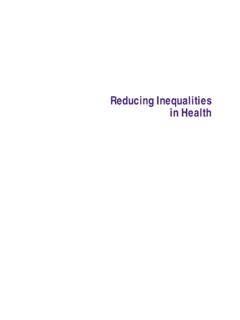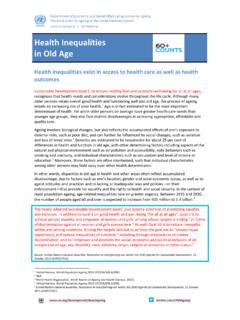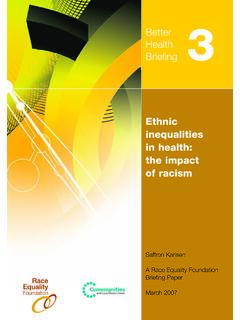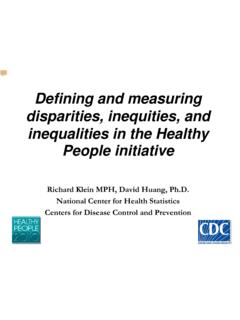Transcription of Overview of Inequalities in Health Experienced by Women
1 1 Overview OF Inequalities IN Health Experienced BY Women WHAT ARE Health Inequalities ? Health Inequalities are the unjust and avoidable differences in people s Health across the population and between specific population groups. Health Inequalities do not occur randomly or by chance, but are socially determined by circumstances largely beyond an individual s control. These circumstances disadvantage people and limit their chance to live longer, healthier lives. The existence of Health Inequalities in Scotland means that the right of everyone to the highest attainable standard of physical and mental Health is not being enjoyed equally across the population. The fundamental causes of Health Inequalities are an unequal distribution of income, power and wealth.
2 Health Inequalities are described and measured by comparing the Health outcomes of different groups. Health outcomes such as life expectancy, healthy life expectancy and rate of disease are compared using groupings that include gender. However the most consistent comparison is between income and area deprivation. We examined what does, and does not, work to reduce Health Inequalities for the Ministerial Task Force on Health Inequalities in 2012. Our Health Inequalities Policy Review shows that tackling Health Inequalities requires a combination of action to: undo the fundamental causes prevent the harmful wider environmental influences mitigate (make less harmful) the negative impact on individuals. Source NHS Health Scotland SOCIAL DETERMINANTS OF Health And personal characteristics- including gender!
3 2 SEX AND GENDER: DEFINITIONS MATTER! Sex and gender are often used interchangeably and as if they mean the same thing, however they do not. The World Health Organization defines sex as the characteristics of Women and men that are biologically determined. People are born male or female but learn to be girls and boys who grow into Women and men. In the policy brief How can gender equity be addressed through Health systems ? WHO says gender refers to socially constructed differences between Women and men, including expectations of roles, and responsibilities, as well as differences in patterns of employment and unpaid work. Gender is a determinant of Health . Many Health conditions, Health behaviours, service access, and exposures to Health risks from wider determinants vary by sex and gender.
4 Gender inequality may be Experienced by Women in relation to the pay gap, occupational segregation, primary caring responsibilities for children/family, gender-based violence and less economic and political power, all of which can contribute to poor Health . Source: ScotPHO, NHS Health Scotland SOME FACTS (as we know them) Prevalence of asthma and depressive illness is higher in Women Prevalence of auto immune disorders is generally higher in Women ; specific examples include rheumatoid arthritis and multiple sclerosis. Incidence rate for stroke is higher in men but mortality is higher in Women Incidence of coronary heart disease, suicide and diabetes is higher in men Source: 3 In the most affluent areas of Scotland, men experience more years of good Health and Women experience more years compared to the most deprived areas.
5 Women tend to live longer but be in poorer Health for longer than men. There are Inequalities in Health within genders as well as between genders Income and area deprivation are consistent and enduring causes of Health inequality across all groups in society we know this because we collect and report this data. What don t we know? Source: ScotPHO, NHS Health Scotland Although the pay gap has reduced from 29% in 1970, mean full-time pay in Scotland in 2015 remained higher for men than for Women . A greater proportion of Women work part-time which tends to be lower paid than full-time employment (Source: Close the Gap). Access to contraception and high quality maternity care are determinants of Health in Women EXAMPLES OF SOCIAL DETERMINANTS of Women s Health Gender-based violence (GBV) Gender based violence (GBV) is a major public Health , equality and human rights issue which cuts across all of social groups.
6 GBV is Experienced unequally, with 17% of Women and 7% of men having Experienced the use of force from a partner or ex-partner at some point in their lives. Globally, two factors related to gender inequality are strongly associated with GBV social norms supporting violence as a means of conflict resolution the unequal position of Women in relationships and society violence occurs at higher levels in societies in which men are viewed as superior and possess the economic and decision making power. Source: NHS Health Scotland Women as paid and unpaid carers As at end June 2016, over three-quarters ( ) of NHSS cotland workforce (whole-time equivalent) were female (106, WTE employees out of 138, WTE) Source: ISD: NHSS cotland Workforce Statistics In 2015 a clear majority of both Social Care* at home clients (62%) and long stay care home residents (69%) were female.
7 Source: Social Care Survey / Care Home Census 4 *Social Care services refer to: Home Care, Telecare / Community Alarm, Housing Support, Direct Payments and Meals services. Carers - 41% of people who provide unpaid care to a relative, friend or neighbour are men; 59% are Women . Source: Scotland s Carers Many Health and social care roles fall at the lower end of income scales. Being an unpaid carer restricts access to education and employment. Education and employment are determinants of Health Caring for children Women are the primary carers for children. Access to affordable childcare is a major barrier to Women being able to work, study and train. Access to employment and education are major determinants of Health . Lone parents are less likely than parents in couple families to report they have good general Health , and more likely to report that they have poor mental Health .
8 In 2015, there were 141,400 lone parents with dependent children living in Scotland. Changes in the amount and security of money flowing into households that are struggling could have a profound impact on a significant part of our population Source: NHS Health Scotland 91% of lone parents with dependent children are Women Source: Office for National Statistics INTERSECTION OF DETERMINANTS Deprivation is the key determinant of Inequalities in Health , although age, gender and ethnicity are also very important factors. We need to know more about the impact of these determinants when they intersect Women are less likely to access antenatal care early and more likely to die in child birth or have complications with their pregnancies if they are poor, have a learning disability or come from a BME community.
9 Source: NICE Black Women in England are almost twice as likely to be diagnosed with advanced breast cancer as white Women . Late-stage disease is found in about 25% of black African and 22% of black Caribbean breast cancer patients. In white breast cancer patients, the figure is 13%. 5 Source: Public Health England + Women +breast+cance&show_organisations_f ilter=true Breast cancer in South Asian Women appears to be lower than the rate found in the general population Source: Cancer Research @ IMPROVING KNOWLEDGE FOR ACTION ACROSS POLICY AND PRACTICE but also,..using what we know relation to childcare, income and social security Better understanding of relationship between biological characteristics and disease patterns Better data that differentiates the impact of inequality on gender and other protected characteristics Understanding intersectionality Developing practice in response access to and design of services






